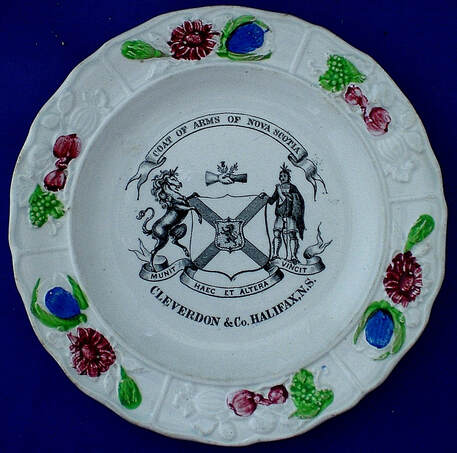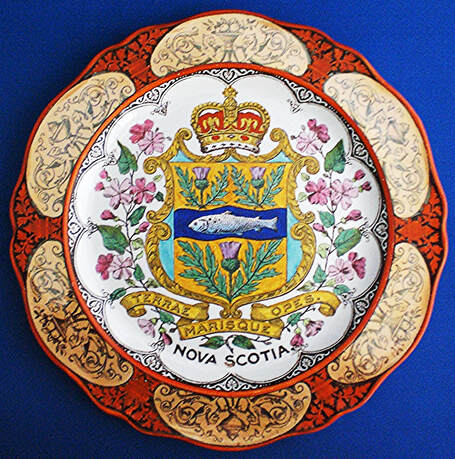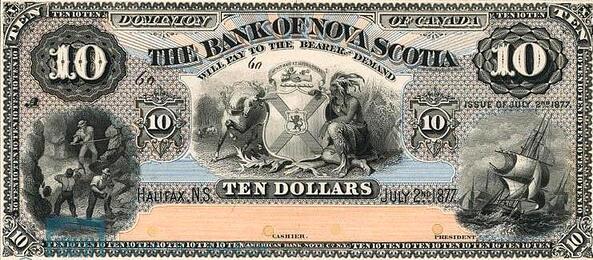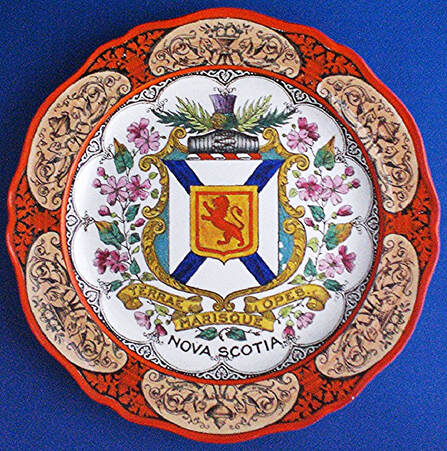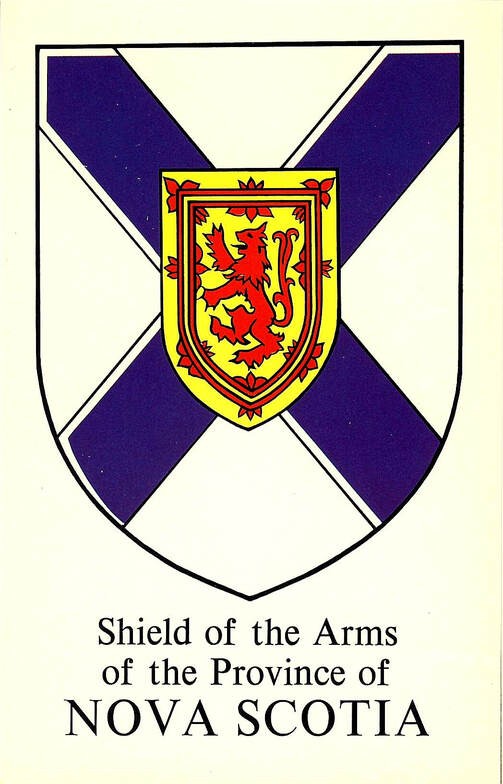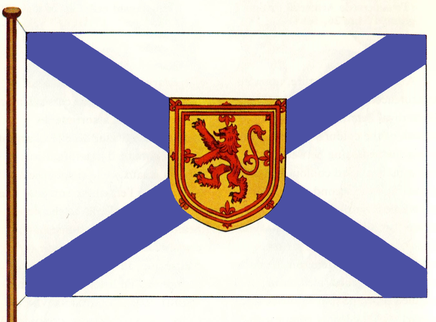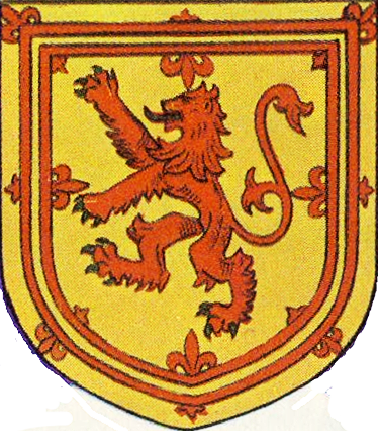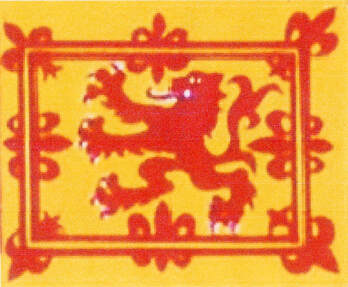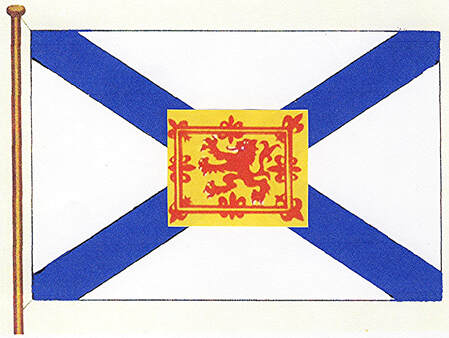A Precursor to the Flag of Nova Scotia
Auguste Vachon, Outaouais Herald Emeritus
A flag design featured on an envelope or cover advertising the Nova Scotia Provincial Exhibition at the very end of the nineteenth century is based on the old arms of the province granted in the seventeenth century (fig. 10). The interest of this older design is that it almost replicates the province’s present flag some 30 years before it was adopted. To trace the genesis of the two flags, it is necessary to outline the history of the two versions of the armorial bearings (arms or coat of arms) of Nova Scotia. The use of a large number of illustrations has greatly helped in achieving this goal.
N.B. Figures 1-2, 4 are from the Auguste and Paula Vachon Collection of Heraldic Ceramics now in Canadian Museum of History. Figures 6, 10 are from their heraldic postcard collection. Figures 8, 9, 11 were produced by the author.
The original armorial bearings of Nova Scotia were granted by Charles I in 1625 or shortly before. These arms appeared on maps of the territory in the early1750’s and continued being displayed in various places for many years (fig. 1). [1] In 1868 just after Confederation, Nova Scotia received a new grant of arms by royal warrant of Queen Victoria. These new arms were quite different from the previous ones (fig. 2), but the new arrival did not completely replace the older emblem which continued to be reproduced on various objects (figs. 3-4). [2]
N.B. Figures 1-2, 4 are from the Auguste and Paula Vachon Collection of Heraldic Ceramics now in Canadian Museum of History. Figures 6, 10 are from their heraldic postcard collection. Figures 8, 9, 11 were produced by the author.
The original armorial bearings of Nova Scotia were granted by Charles I in 1625 or shortly before. These arms appeared on maps of the territory in the early1750’s and continued being displayed in various places for many years (fig. 1). [1] In 1868 just after Confederation, Nova Scotia received a new grant of arms by royal warrant of Queen Victoria. These new arms were quite different from the previous ones (fig. 2), but the new arrival did not completely replace the older emblem which continued to be reproduced on various objects (figs. 3-4). [2]
Fig. 1. Advertisement plate by Wedgwood & Co., England, c. 1850-1865 featuring the 1625 arms of Nova Scotia. This Wedgwood company is not the same as the one mentioned with figures 2 and 4.
Fig. 2. Decorative 1908 Wedgwood plate with the arms assigned to the province of Nova Scotia by Queen Victoria in 1868. The granted arms are exclusively what appears on the central shield. The additions around the shield do not belong to the arms, namely: (1) the royal crown which was often placed above provincial arms without royal authorization; (2) the baroque framing around the central shield; (3) sprays of mayflower, the provincial floral emblem, on both sides of the shield; (4) the motto inscribed on a scroll underneath, Terrae Marisque Opes (Resources from land and sea), is taken from the 1730-1767 Great Seal that George II assigned the province.
Fig. 3. Bank of Nova Scotia, ten-dollar bill, July 2, 1877, Bank of Canada Currency Museum Collection.
Fig. 4. Decorative 1907 Wedgwood plate showing the 1625 arms of Nova Scotia with the crest on top, but without the supporters as in figure 1. The added elements are described with figure 2.
On 19 January 1929, a warrant of King George V restored the seventeenth century arms of Nova Scotia with the same components as the old ones, but with a helmet added between the shield and crest, which is a normal practice (compare figures 1 and 5). The royal warrant stated that the arms could be borne “upon Seals, Shields, Banners or otherwise according to the Law of Arms.” These words authorized the content of the shield (fig. 6) to be displayed on the whole surface of a squarish or rectangular banner, and the province adopted its provincial flag accordingly (fig. 7).
Fig. 5. Armorial bearings of Nova Scotia originally assigned by Charles I in 1625 or shortly before, restored by royal warrant in 1929. From The Arms, Flags and Floral Emblems of Canada (Secretary of State of Canada, 1967).
Fig. 6. From a postcard booklet reproducing the arms of Canada, its provinces and territories. It can be dated close to 1965 because it states on one of the cards that the population of British Columbia is 1.8 million at the time. In heraldry gold, as on the central escutcheon in this illustration, can be represented as yellow or given a more metallic appearance. “A Traveltime product, made in Vancouver, Canada, by Grant-Mann lithographers Ltd.”
Fig. 7. Flag of Nova Scotia assigned by royal warrant in 1929 and replicating, on a rectangular surface, the elements on the shield as seen in figure 6. Same source as figure 5.
Fig. 8. Royal arms of Scotland placed in the centre of both the Nova Scotia arms and flag. They are blazoned: Or a Lion rampant within a double tressure flory-counter-flory Gules. The double tressure consists of the two parallel red stripes shaped as the shield; flory-counter-flory describes the fleurs-de-lis on the stripes pointing alternately in one direction, then in the other.
Until recently, I did not know that there had been at least one attempt to create a provincial banner based on the seventeenth century shield. I discovered this while consulting Joachim R. Frank, The Postal History of the Canadian Participation in the South African War, 1899-1902 (BNAPS, 2013), p. 43. The envelope illustrated in his work is postdated 27 March 1900 and was sent by a soldier from Sea Point C.G.H. (Canadian General Hospital) in Cape Town to someone in Toronto, during the South African War. The author further informs us that such envelopes or covers were donated to be used as stationery, which might explain their availability to Canadian troops in South Africa. The cover in this article (fig. 10) was sent from Halifax to Charlottetown in 1899. Like the others, it is illustrated with a flag in colour and inscribed: “Nova Scotia Provincial Exhibition, Halifax. Sept. 23 to 30 1899. M.S. Lith. Co. St. John & Halifax. $17,000 IN PREMIUMS.” The premiums no doubt represents amounts paid by exhibitors.
By comparing figures 6, 7 and 8 to figures 9, 10 and 11, the difference between today’s flag and the one on the exhibition envelope becomes apparent. Figure 7 is a banner of the arms which duplicates faithfully the entire content of the shield (fig. 6) on a rectangular surface. Figure 10 introduces a minor change where the smaller shield in centre, called an escutcheon or inescutcheon, becomes a rectangular banner with the same content as the shield. More precisely, the former displays the royal arms of Scotland (figs. 7-8) over the blue saltire while the latter displays the royal banner of Scotland (figs. 9-10) over the same cross. Figure 11 was created because the details of the royal banner of Scotland in centre of the flag are not very clear in figure 10.
By comparing figures 6, 7 and 8 to figures 9, 10 and 11, the difference between today’s flag and the one on the exhibition envelope becomes apparent. Figure 7 is a banner of the arms which duplicates faithfully the entire content of the shield (fig. 6) on a rectangular surface. Figure 10 introduces a minor change where the smaller shield in centre, called an escutcheon or inescutcheon, becomes a rectangular banner with the same content as the shield. More precisely, the former displays the royal arms of Scotland (figs. 7-8) over the blue saltire while the latter displays the royal banner of Scotland (figs. 9-10) over the same cross. Figure 11 was created because the details of the royal banner of Scotland in centre of the flag are not very clear in figure 10.
Fig. 9. Royal banner of Scotland often referred to as a standard.
Fig. 10. This flag differs from the actual provincial flag in that it reproduces the royal banner of Scotland in the centre rather than the royal arms of Scotland as in figure 7. Printed by Maritime Steam Litho. Co., St. John, N.B. and Halifax, N.S.
Fig. 11. Flag combining a blue saltire on a white field with the royal banner of Scotland. This illustration shows clearly the components of the flag in figure 10.
The same banner as figure 10 appeared on the cover of the Nova Scotia Provincial Exhibition (Halifax) in both 1900 and 1908. The 1901 envelope features the 1625 arms as a full achievement, which arms are repeated on the 1902 envelope along with those of the city of Halifax. In 1904 an allegorical figure holds the shield alone, which shield reappears also on the 1905 envelope. On the 1909 cover, the 1625 shield gives way to the 1868 one. These illustrated covers demonstrate that the older 1625 grant was often more popular than the 1868 one. The example of the banner on the envelopes (1899, 1900 and 1908) is of historical interest because it may constitute the only attempt before 1929 to design a flag representing Nova Scotia based almost entirely on its seventeenth century arms.
There can be little doubt that the flag was meant to designate Nova Scotia given that it is based on the provincial arms assigned by King Charles I to the province. On the envelopes, it alternates with the two coats of arms of the province and fulfills the same function that the arms do. This flag is correct heraldically and could have been an interesting and appropriate alternative to today’s flag, though not necessarily more efficient or more pleasing aesthetically. In the case of armorial banners or banners of the arms, the most frequent practice is an unchanged transfer of the shield of arms, but variations do occur. Three other Canadian provinces have armorial banners: British Columbia and New Brunswick replicate exactly what is on their shield, while Prince Edward Island adds a border alternating red and white to the composition.
There can be little doubt that the flag was meant to designate Nova Scotia given that it is based on the provincial arms assigned by King Charles I to the province. On the envelopes, it alternates with the two coats of arms of the province and fulfills the same function that the arms do. This flag is correct heraldically and could have been an interesting and appropriate alternative to today’s flag, though not necessarily more efficient or more pleasing aesthetically. In the case of armorial banners or banners of the arms, the most frequent practice is an unchanged transfer of the shield of arms, but variations do occur. Three other Canadian provinces have armorial banners: British Columbia and New Brunswick replicate exactly what is on their shield, while Prince Edward Island adds a border alternating red and white to the composition.
Notes
[1] A plan of the harbour of Chebucto and town of Halifax. | Library of Congress (loc.gov) and
Plan des Havens von Chebucto und der Stadt Halifax | Library of Congress (loc.gov).
[2] For further information regarding the two versions of the Nova Scotia arms, see: http://ash.heraldry.ca/issues/2011_2012/ASH_4_10_Vachon_NS_Arms.pdf
[1] A plan of the harbour of Chebucto and town of Halifax. | Library of Congress (loc.gov) and
Plan des Havens von Chebucto und der Stadt Halifax | Library of Congress (loc.gov).
[2] For further information regarding the two versions of the Nova Scotia arms, see: http://ash.heraldry.ca/issues/2011_2012/ASH_4_10_Vachon_NS_Arms.pdf
